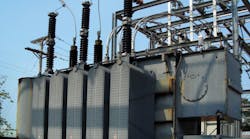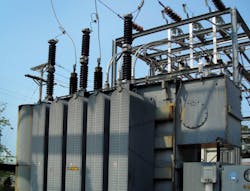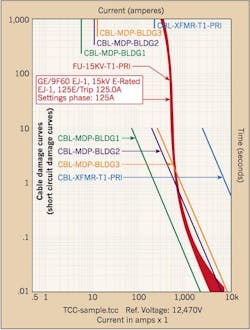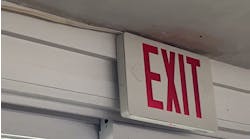NEC Guidelines for Transformer and Transformer Feeder Protection
Note: All Code references are based on the 2014 NEC.
The NEC has separate sections for transformer feeder protection and transformer protection. Article 240 lists requirements for transformer feeder protection, while Art. 450 provides requirements for transformer protection. The Fine Print Note of Sec. 450.3 states the relationship between the two different Articles: “the overcurrent protection required by Art. 450 may also satisfy the requirements in Art. 240 for conductor protection, and vice versa, but it is also possible that they do not.” So although the two Articles are related, meeting one set of requirements does not necessarily mean it meets the other when it comes to overcurrent protection.
With Exceptions listed in Sec. 240.4(A) through (G), overcurrent protection is required for conductors.
“Conductors, other than flexible cords, flexible cables, and fixture wires, shall be protected against overcurrent ...” [240.4].
Furthermore, overcurrent protection is required for electrical conductors at the point where power is received.
“Overcurrent protection shall be provided in each ungrounded circuit conductor and shall be located at the point where the conductors receive their supply except as specified in Sec. 240.21(A) through (H)” [240.21].
However, there are a few Exceptions associated with these requirements. Let’s review those now.
Protection at the primary side of the transformer
Transformer primary protection — Overcurrent protective devices (OCPDs) are required as primary protection for transformers when the primary voltage is greater than 1,000V [Tables 450.3(A)] and for transformers with primary voltage of 1,000V or less [Table 450.3(B)], with no Exceptions. However, a fire pump has a special requirement for its transformer primary and secondary protection, which is considered a modification to Art. 450. If a transformer serves a fire pump (Art. 695), its primary OCPD shall be sized per the locked-rotor current of the fire pump, and transformer secondary protection shall not be permitted [695.5(B)].
Transformer primary feeder protection — The NEC does not list any specific Exception for transformer primary feeder protection. An OCPD is required for the transformer primary conductor. The only Exception is found in Sec. 240.4(A). If overload protection of the OCPD would create a power loss hazard, such as fire pump application and some processes at refinery facilities, the overload protection shall not be required. However, short circuit protection is still required. As a reference, Sec. 695.4(B)(2)(a)(1) and (2) requires the overcurrent device for a fire pump(s) to be sized per locked-rotor current of the largest fire pump motor and shall not open within 2 minutes at six times the full-load current of the fire pump motor(s).
Protection at the secondary side of the transformer
Transformer secondary protection — Although OCPDs are required as primary protection for transformers with no Exception, there are a few scenarios where overcurrent protection is not required at the transformer secondary, as per Tables 450.3(A) and 450.3(B).
Transformer secondary protection is not required for the following conditions:
- For transformers with primary voltage greater than 1,000V at supervised locations, with the following maximum primary protection [Table 450.3(A)]:
a. Circuit breaker size up to 300% of or fuse rating up to 250% of transformer-rated current, for transformers with secondary voltage greater than 1,000V.
b. Circuit breaker size or fuse rating up to 250% of transformer-rated current, for transformers with secondary voltage 1,000V or less. - For transformers with primary voltage 1,000V or less and current of 9A or more, with primary protection not more than 125% of transformer-rated current, the “next-size-up” rule can be applied [Table 450.3(B)]. Please note that requirements for transformers with current less than 9A are not listed here.
- As per Note 5 in Table 450.3(A), “A transformer equipped with a coordinated thermal overload protection device by a manufacturer shall be permitted to have separate secondary protection omitted.”
As per Note 3 of Table 450.3(A), “A supervised location is a location where conditions of maintenance and supervision ensure that only qualified persons monitor and service the transformer installation.”
| Check out this additional article on transformer conductor protection: Transformer Secondary Conductor Protection for Systems Operating at Greater Than 1,000V |
Transformer secondary feeder protection — Typically, transformer secondary feeder protection is required except for a few conditions listed in Sec. 240.21(C)(1) through (6). For those Exceptions, the next-size-up rule shall not be permitted. Section 240.4(B) notes that the next higher standard overcurrent device rating (above the ampacity of the conductors being protected) shall be permitted, provided the conditions listed on 240.4(B)(1) through (3) are met.
a. Primary side protection is allowed as secondary feeder protection when the following requirement is met [240.21(C)(1)]. Per 240.21(C)(1), for a single-phase transformer having a 2-wire (single-voltage) secondary or a 3-phase, delta-delta connected transformer having a 3-wire (single-voltage) secondary, secondary feeder shall be permitted to be protected by an OCPD on the primary side of the transformer, “provided this protection is in accordance with Sec. 450.3 and does not exceed the value determined by multiplying the secondary conductor ampacity by the secondary-to-primary transformer voltage ratio.” A note in Sec. 450.3 mentions that it is not necessary to duplicate overcurrent protection at the transformer secondary side, as long as the OCPD on the primary side protects the transformer (meeting 450.3 requirements) and protects the feeder (meeting 240.21 requirements). A possible reason to have Sec. 240.21(C)(1) is that the primary side OCPD sees the same per unit fault current at the transformer primary side as that at the secondary side.
For any other type of transformer, the secondary conductor is not required to be protected by an OCPD at the transformer primary [240.4(F)]. For example, if an OCPD is only applied to the high-voltage, delta side of a delta-wye grounded transformer, the device can have a problem providing sensitive fault protection for the transformer. For a low-voltage (wye side) line-to-ground fault, the high-side line current is only 58% of the low-voltage, per-unit fault current [Sec. 11.9.2.2.3.1 of IEEE standard 242-2001].
b. A secondary conductor OCPD is not required when the conductor is short and meets the following requirements — providing other requirements in the NEC are met, such as minimum cable ampacity [240.21(C)(2),(3),(5) and (6)].
- Secondary conductor is not greater than 10 ft in length [240.21(C)(2)];
- Industrial installation secondary conductor is not greater than 25 ft in length [240.21(C)(3)];
- Secondary conductor from a feeder tapped transformer, primary plus secondary, is not greater than 25 ft in length [240.21 (C)(5)];
- Secondary conductor is not greater than 25 ft in length [240.21(C)(6)].
c. Overcurrent protection is not required for outside secondary conductors when the following requirements are met [240.21(C)(4)].
It is common to use an exterior transformer to feed a single building or multiple buildings through outside secondary conductors. As long as they meet ALL of the following requirements listed in Sec. 240.21(C)(4), an OCPD is not required at the secondary side of the transformer.
- The conductors are protected from physical damage in an approved manner.
- The conductors terminate at a single circuit breaker or a single set of fuses.
- The overcurrent device for the conductor is an integral part of a disconnect means or shall be located immediately adjacent thereto.
- The disconnect means for the conductors is installed at a readily accessible location complying with one of the following:
a. Outside of a building or structure.
b. Inside, nearest the point of entrance of the conductors.
c. Where installed in accordance with Sec. 230.6, nearest the point of entrance of the conductors.
A possible reason to have Sec. 240.21(C)(4) is there is a very low incidence rate of faults occurring on the exterior protected secondary conductor in the “approved manner.” Therefore, the risk factor for fire hazards or property damage may be low. The NEC does not specify what “approved manner” is for the conductor protection. It might require AHJ’s interpretation and approval. Using an underground concrete-encased duct bank with required concrete strength, encasement thickness and bury depth can be an “approved manner” for this application.
Discussion for Section 240.21(C)(4)
Although the NEC allows you to omit transformer secondary feeder protection when the design and construction arrangement meets the requirements set forth in Sec. 240.21(C)(4), there are a few concerns or considerations worth mentioning.
Figure 1 (click here for a PDF version) shows an example in which an outdoor transformer feeds multiple buildings with multiple secondary feeders. For this particular design arrangement, assume the system meets the requirements in Table 430.3(A) and Sec. 240.21(C)(4). Thus, no OCPD is required at the transformer secondary.
Concern No. 1 — Lack of an OCPD on the transformer secondary may make it difficult to coordinate overcurrent protection for the power distribution system. In this example, any single fault on a secondary feeder may trip the primary fuse. This would result in a power outage for all buildings fed by this transformer.
Concern No. 2 — While other subsections of 240.21(C) include requirements for secondary conductors, subsection (4) does not list a minimum cable size for outside secondary conductors. [Even the primary protection is not considered to protect the secondary feeder from Sec. 240.4(F) — although it may protect the feeder anyway, especially at high fault current (short circuit) range, due to omission of the secondary protection.] However, if the secondary feeder is sized relatively small, for example 1/0 AWG cable for Building No. 1 in the example, the cable-rated allowable short circuit current from the Insulated Cable Engineers Association (ICEA) might be less than the available fault current at the cable. When looking at time-current characteristic curves (TCC) on a log-log graph, the cable damage curve needs to be to the right of the OCPD tripping curve so it can be protected by the OCPD. As shown in Fig. 2, the cable damage curve for the 1/0 AWG cable is on the left of the primary fuse tripping curve. This means the cable is not protected by the fuse, and its insulation may be damaged before the fuse clears the fault.
Concern No. 3 — Lack of overcurrent protection at the transformer secondary may delay the process of clearing an arc fault, because the primary OCPD may not be sensitive enough to see it right away. This means that an electrician working on the secondary side of the transformer would be required to use a greater level of personal protective equipment (PPE). Arc flash calculation results are noted in Fig. 1 at each bus. PPE level 0 is required at the primary side of the transformer. However, the PPE category is “dangerous” at the secondary side of the transformer. Annex B in IEEE Standard 1584 states that “two seconds is a reasonable maximum time for (arc flash) calculations.” A clearing time of more than two seconds is observed for the primary fuse in the example.
Concern No. 4 — We may be able to save some costs by omitting the OCPD at the transformer secondary. However, due to the fact that the next-size-up rule can’t be used with the application of Sec. 240.21(C)(4), this might require you to increase the size of the secondary conductor. Cost analysis is required to compare the savings from the omitted OCPD with the extra cost from the larger feeder.
Concern No. 5 — Section 240.21(C)(4) does not list a maximum number of outside secondary conductors that can be connected to the transformer secondary when secondary conductor overcurrent protection is not required. Although Note No. 2 of Tables 450.3(A) and 450.3(B) requires no more than six OCPDs (i.e., breakers or fuses) grouped in one location as transformer secondary protection, Sec. 240.21(C)(4) doesn’t have a specific requirement for the number of secondary conductors to connect to the transformer secondary without protection. It can be unlimited.
Although the NEC permits a few Exceptions to omit overcurrent protection for a transformer and for transformer feeders, we, as engineers, need to make engineering judgments considering the cost (savings from eliminating breakers versus the extra cost of increasing the size of the feeders), safety (arc flash protection), and property protection (overcurrent protection).
Yan is an associate electrical engineer in the Aviation & Facilities Group at Burns & McDonnell in Brea, Calif. He can be reached at [email protected].






